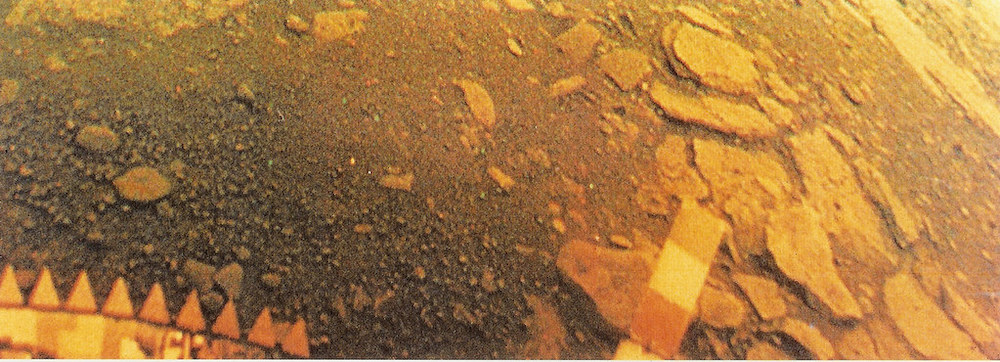September 25, 2020
Meanwhile On Planet VENUS...





..13 Russian space probes are scattered across the surface, 3 reduced to cinders 10 crushed, melted and dissolved by heat, pressure and acidic atmosphere akin to that near the mouth of an underwater volcano.
"Our country [the Soviet Union] was the first and only one to successfully land on Venus,†[Dmitry Rogozin, the director general of Russian space agency] said in an interview with The Times. "The spacecraft gathered information about the planet — it is like hell over there.â€"We believe that Venus is a Russian planet,†he added.
There are a couple of ways to take this affront to the Outer Space Treaty.
1: Assume it was said in jest. Take it not seriously at all.
2: Embrace this affront to the Outer Space Treaty and let them have Venus. After all. Given that precedent, we've got footprints on The Moon! Those flags were artesianally erected! It's an American Mercury sized spacerock!
Ahem. Then of course there's the matter of Mars, which is as American as Venus is Russian, and Titan, which using that logic is currently owned by Brussels.
This non-sequitur comes on the heels of a recent discovery that might indicate life on the hellish planet.
Specifically, a team of scientists from Cardiff University have discovered phosphine gas in the clouds of Venus.
Now on Earth, Phosphine is produced in two ways. One is by chemists mixing white phosphorus and sodium hydroxide or potassium hydroxide, and the other is anaerobic bacteria, doing their anaerobic thing. On Earth bacteria are the only natural source so to see this gas in the clouds of Venus is seen as being a possible biosignature. Also, the gas is highly toxic to aerobic (oxygen breathing) life, it's only a signature of anaerobic life, which, due to the lack of free oxygen on Venus would be the only life that might stand a chance.
I only have a degree in History, so I'll let one of our crack team of science babes explain why skepticism might well be warranted.

A lack of oxygen is the least of the problems with life on Venus. The temperatures and pressures are far beyond anything even the most hardy extremophiles on Earth can endure. At the temperatures at Venus's surface, organic chemistry breaks down.

Venus dirt as photographed by Vega 13 moments before it imploded, and presumably melted and dissolved in the high pressure acid bath.
One theory is that the anaerobes exist high in the atmosphere (where the phosphine is). How the bacteria would fly/float 20-50 miles up is unexplained. While on Earth the only natural source of Phosphine is anaerobic bacteria, Venus, by virtue of its temperatures, pressures and highly reactive chemical soup of an atmosphere, might be pulling off chemistries we don't understand.
Indeed.
In an earlier post we noted that Vega 13 which took the above picture had detected phosphoric acid (H3PO4) in the lower atmosphere. In fact, at the lower levels of the Venusian atmosphere, Phosphoric Acid is in similar proportions to what the Sulphuric Acid is at higher altitudes. Phosphine is H3P. So in this crucible of ungodly pressures and temperatures, all that is needed to create Phosphine is somehow drop the 4 oxygens from Phosphoric Acid, note too that Phosphine because of its composition is much lighter and so would float up.
I'd frankly sooner expect glaciers on Mercury than life on Venus.
So I wouldn't completely rule out life in the clouds. Still, I think the non-biological explanation is more likely.
However,
This might still be big news.
IF there IS phosphine in the clouds at the human habitable altitudes and IF this isn't bound up in some fragile ecosystem, then a floating cloud base on Venus could filter out phosphorus for use on Mars and other places.
We mentioned this in the earlier post when looking for something that might make the proposed cloud bases. economically viable, though in that case we were thinking of pulling up the phosphoric acid from 20 miles down, which was a logistical matter we did not dwell upon. If phosphorus is in phosphine gas at the habitable altitudes then phosphorus extraction becomes much simpler. Phosphorus is pretty important, to the extent that assuming settlements on the Moon, Mars and in habitats, it could be the Dilithium, Spice Melange, or Vibranium of a real solar economy. Heck, with concerns about "peak phosphorus" it might be something from space that would actually make economic sense to have shipped to Earth. I don't know what processes or reagents would be needed to crack phosphine but it bears some investigation.
A lot depends on what concentrations this recently discovered phosphine is in, whether or not it's tied up in some unearthly ecosystem, and, in the unlikely event that it is, if it can be harvested in commercially viable quantities without destroying the biome that produces it. However as we mentioned in the earlier post Venus has 4 times as much sunlight as earth, 4 times as much Nitrogen, Calcium, and Phosphorus plus, Water and Oxygen can be cracked from the atmospheric acids. A hypothetical floating outpost on Venus as proposed by NASA in 2014, can mine Phosphorus and Nitrogen....and grow its own food, perhaps a surplus of food, and because breathable air is a lifting gas on Venus, the floating part is fairly straightforward. A exploitable source of phosphorus could be a huge boon for agriculture here on earth as well as make it much more practical to to expand human presence throughout the solar system. To that latter end as well, the nitrogen, of which Venus has 4 times as much of as earth would be invaluable in providing air to habitats throughout the solar system.
Brickmuppet Blog may not be the only outfit mulling over this hairbrained scheme. After all it was right after the Phosphene was confirmed to exist that the head of the Russian Space Agency declared the most inhospitable planet in the inner solar system to be Russian.

NASA's Project HAVOC which we mentioned in detail in the earlier post. One interesting thing that was noted in the report was that the light is so intense at Venus that solar panels can be put on the bottom of the floating station and sunlight reflecting off the clouds will give them better performance than those on Earth.
Posted by: The Brickmuppet at
05:29 PM
| Comments (2)
| Add Comment
Post contains 1064 words, total size 10 kb.
1
On the other hand, the Russian Venus landers sent back data for as much as two hours before they collapsed, crushed and melted, into little gooey blobs. That's something.
Posted by: Pixy Misa at Mon Sep 28 23:28:13 2020 (PiXy!)
2
While Kirisu's skepticism is warranted, I'll note that scientists said the exact same things about life at the bottom of oceanic trenches. Then they found it there.
Posted by: StargazerA5 at Tue Sep 29 10:40:07 2020 (08rf8)
41kb generated in CPU 0.017, elapsed 0.0831 seconds.
71 queries taking 0.0722 seconds, 380 records returned.
Powered by Minx 1.1.6c-pink.
71 queries taking 0.0722 seconds, 380 records returned.
Powered by Minx 1.1.6c-pink.









